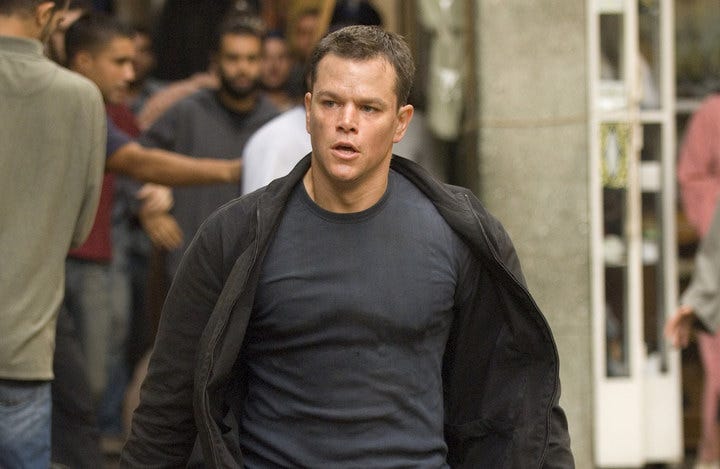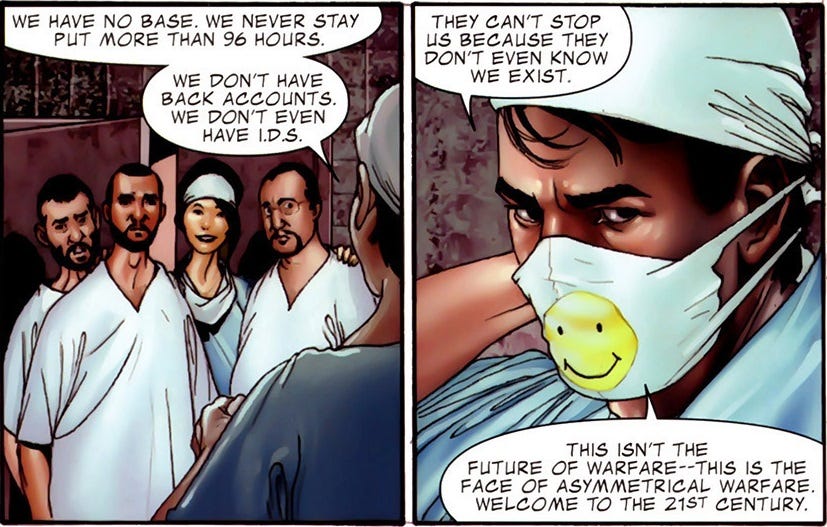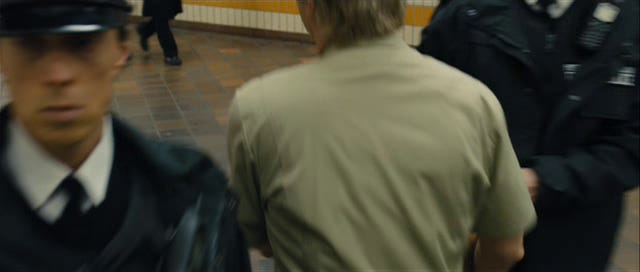Bond vs the anti-Bourne: 4GW and the Collapse as a Survival Horror.
[UNLOCKED] bonus 003 - 31st March, 2019
MKY: Here’s an unpublished, lightly updated piece from a couple years back I like to call Bond vs the anti-Bourne, taken from one of my classic megaposts that almost was, Lifestyle Tips for the Empire 2.0: Ghostin' in the Surveillance Marketing State
Enjoy.
*all emphasis in quotes, mine, etc.
//
Here is Jason Bourne looking every bit the Gray Man.

Just as a refresher, here's the definition again of this covert dress aesthetic, pulled from an interview with William Gibson:
They teach people to dress unobtrusively. Chinos instead of combat pants, and if you really need the extra pockets, a better design conceals them. They assume, actually, that the bad guys will shoot all the guys wearing combat pants first, just to be sure. I don’t have that as a concern, but there’s something appealingly “low-drag” about gray man theory: reduced friction with one’s environment.
The Gray Man blends in to his environment, becomes one with it.
Bourne joins completely with his. As Matt Jones detailed so perfectly on his blog - prefiguring his classic "City As A Battlesuit" post for io9 – in The Bourne Infrastructure:
Rather than Bond’s private infrastructure expensive cars and toys, Bourne uses public infrastructure as a superpower.
A battered watch and an accurate U-Bahn time-table are all he needs for a perfectly-timed, death-defying evasion of the authorities.
... in addition, Bourne wraps cities, autobahns, ferries and train terminuses around him as the ultimate body-armour, in ways that Old Etonians could never even dream of.
The Bourne-Bond duality is one we're going to play with a lot here.
Extending it out to be a general pattern to describe the territory that lies between the Network and the Privilege Bubble.
Bourne is’ the spy with no name’, only aliases. No personal history, his memory erased. Product of a rather MK Ultra-looking secret government program that even the CIA claims ignorance of. Living off-the-grid, existing on a no-frills budget.
He is the Ghost of the Network, personified.
Bond, James Bond... is the man who lives by his name and reputation.
Agent of the state, with the seemingly inexhaustible expense account.
Bond: resigns in CASINO, rogue in QUANTUM, SKYFALL, & SPECTRE. Technically not a spy, just a paranoid unemployed alcoholic serial murderer.
Even when he's been disavowed, sent on vacation, straight resigned or otherwise not strictly acting in the interests of - or under the protection of - the Crown, Bond's so far inside the Privilege Bubble that he just naturally, magically, seems to gain access to all its inherent perks - fast cars, exotic hotels.
As Jones says, he's the resident of "the international late-capitalist nonplace."
Contrast this with Bourne's filmic universe, which is grounded and navigable:
the first and the last are set in Schengen – a connected, border-less Mitteleurope that can be hacked and accessed and traversed – not without effort, but with determination, stolen vehicles and the right train timetables.
Bond is the haunted exemplar of the post-War era, the Jet Set Age.
Bourne is the nearly invisible icon of the Network era, the Internet Age.
The interplay between these two archetypes drives the plot of our own times.
4GW Heroes & Villains
In an earlier post - Who Stole My Volcano? Or: How I Learned to Stop Worrying and Love the Dematerialisation of Supervillain Architecture - Matt Jones starts building the case for a new kind of Bond Villain, one from the Network.
A Fourth Generation Warfare (4GW) kind of Bond Villain.
He does this by extending his thinking beyond Bond, moving from the filmic spy-fi universe into the comic book sci-fi universe, to draw upon the example of another Jet Set-era character: Tony Stark.

I'll quote pretty generously from Jones' post here, and, in doing so pull in his own quotes from Matt Fraction himself talking about writing Invincible Iron Man.
Frayling pointed out this repeating formula in the 60s and 70s Bond movies to the audience. A hidden fortress, that had to be discovered, infiltrated and destroyed with a girl/goddess as guide – but not to be destroyed before we could take in some of the fine lifestyle touches that supervillainy gave as rewards.
But then in an almost throw-away aside to Adam, he reflected that the modern Bond villain (and he might have added, villains in pop culture in general) is placeless, ubiquitous, mobile.
His hidden fortress is in the network, represented only by a briefcase, or perhaps even just a mobile phone.

Perhaps the architypical transformation from gigantic static lair to mobile, compact “UbiLair” is in the film Spartan, where Val Kilmer’s anti-heroic ronin carries everything he needs in his “go-bag” – including a padded shooting mat that unfolds from it, to turn any place into a place where he holds the advantage.
Moving beyond spy-fi filmic universes and back into the comic sci-fi ‘verise, I can’t help but immediately think of my favourite supervillain of the year, Ezekiel ‘Zeke’ Stane from Matt Fraction‘s masterful run on the comicbook Invincible Iron Man.
As Fraction puts it:
Zeke is a post-national business man and kind of an open source ideological terrorist, he has absolutely no loyalty to any sort of law, creed, or credo... He has no headquarters, no base, and no bank account. He’s a true ghost in the machine; completely off the grid, flexible, and mobile. That absolutely flies in the face of Tony’s received business wisdom and in the way business is done. There are banks and lawyers and you have facilities and testing. Stane is a much more different animal. He’s a much smarter, more mobile and much quicker to respond and evolve futurist.
Zeke has no need for specialised infrastructure beyond commodity gear that he can improvise and customise. He doesn't need HeliCarriers or giant military-industrial infrastructure like Tony Stark.
He just needs his brain and his hate. As Fraction says in an interview:
I was trying to figure out what a new Iron Man would look like, and I figured, well, there wouldn't be a suit anymore. The user would be the suit. I just started to riff on that, on cybernetics and riffing on weaponized bodymod culture stuff. Tony’s old money, old world, old school and old model manufacture. So where would Stane, a guy that had no manufacturing base and no assembly facilities, get his tech? Everything would need power sources, so how would that work? Where would the surgeries be performed? How would he pay for it? What’s his ideology? I started reading up on 4G war and warfare. And on and on until I understood Stane’s reality, and how Stane would wage war on Stark Industries and Tony both.
So that's Zeke Stane vs Tony Stark established as another instance of the pattern we're sketching out.
On the side of privilege and old money we have Tony Stark and James Bond.
On the side of off-the-grid living and adapting everyday objects as weapons (and shields) we have Zeke Stane and Jason Bourne.

Zeke Stane turns bodies into weapons, and is his own prototype.
He is a continual work-in-progress. Eternally becoming. The ubermensch as a revenge-driven punk grinder kid.
Jason Bourne has been forged into the perfect assassin - mentally and physically.
Everything is a resource for him to be creatively re-purposed.

Bourne can use a pen to win a knife fight.
He can read a map to find an unconventional path through a city to evade pursuers:
But wait - a corner of your brain is saying, I hear it too - Zeke Stane is the bad guy!
Sure, we can see Jason Bourne asa 4GW Spy, but not as a Bond Villain!
Like, one man's terrorist is another man's freedom fighter, obviously.
Just as one state's spy is another state's subversive element, and all that...
But that's what we want though, right? Bond vs the 4GW Spy.
The great Bond vs anti-Bourne showdown.
SKYFALL: The crypto tale of Bond vs the anti-Bourne
Reader, I put it to you that we've already seen James Bond fight a perversion of Jason Bourne; that this scenario was played out in Skyfall.

In the film Bond's tool kit is the usual: a piece of high end tech from Q.
In this case, a gun with a biometric lock; meaning only he can fire it. Only Bond is privileged to use it.

It is in fact his sole weapon.
His adversary in Skyfall is a former agent turned rogue hacker (the seemingly almost mandatory stand-in for Assange or Snowden or Anonymous [1]).
Raoul Silva (played with great delight and relish by Javier Bardem):

As he's introduced in a review by the Telegraph:
...a former agent turned vengeful computer hacker, is nimbler than ever.
Silva is almost as inscrutable as The Dark Knight’s Joker himself: Bardem’s lip-lickingly camp turn makes him the oddest Bond villain since the Roger Moore era, and his nicotine hair flops queasily over his forehead in a way that calls to mind Julian Assange. By acknowledging the rise of cyberterrorism in the same way Nolan played on the West’s new vulnerability in the wake of 9/11, Skyfall is a Bond film for the Anonymous generation.
But in the film's final battle, when Silva comes to fight Bond he wraps the city's infrastructure around him in the same way as Bourne does.
First, he appropriates the cultural norms of the State to hide in plain sight.


Then he hacks the infrastructure to evade his pursuers. Effortlessly 'walking through walls' [2] by accessing restricted doorways (hacking another kind of privilege):

Or just plain using infrastructure for the purposes they were never intended (which, again is hacking it in the same way walking-through-walls is a 4GW tactic).

Recall again Bourne's car chase scene in The Bourne Identity. Note that it's the idea of creative recontextualization, not the scale on which it's implemented - it can be an everyday object or a piece of infrastructure; an entire transportation network or an ideology.
Thus, in the final showdown, just as Bond think he's caught the Villain (in that classic Bond pose):

Silva pulls that canonical Bourne Battlesuit Manoeuvre: using nothing more than a watch and a train schedule and some well placed explosives:


Only, where Bourne uses these simple tools to evade, Silva uses them to attack.
He hits Bond with a train. A fancy, 21st Century gun is not what you bring to a train fight.
THIS IS THE CITY AS A BATTLE SUIT, ALRIGHT.
It's both body-armour and mech suit (something I wrote about in my review of Pacific Rim).
Raoul Silva has bonded so completely with the urban environment that he can use bits of it as limbs for combat.
Thus empowered he can turn a train into a rocket punch.
And there you have it, Bond vs the Anti-Bourne unpacked and elaborated.
Thus ends the lesson.
2019 Postscript/Personal Notes
I want to make one thing very clear, this is no way meant to venerate or celebrate any form of terrorism. We held back this post two weeks, because sending it out right after the white nationalist stochastic terrorist attack in Christchurch, New Zealand felt like poor timing, to put it mildly.
When I was writing this in 2016 I was envisaging the world we regular people will have to navigate as breakdown of western civilisation (its fucking imploding in slow motion) escalates. As a futurist, I seriously hate being right a lot of the time. Just as I’ve written about cyberpunk, futurism too should be as much a warning as it is prediction. That’s why I’m forced to append Critical to the word Futurist when I use that label to describe myself. Too often Futurism is conflated with #progressporn and gadget worship, but as Jamais Cascio points out in Twelve Things Journalists Need To Know to be Good Futurist/Foresight Reporters:
8. Gadgets are not futurism. Don't get too enamored of "technology" as the sole driver of change. What's important is how we use technology to engage in other (social, political, cultural, economic) activities. Don't be hypnotized by blinking lights and shiny displays -- ask why people would want it and what they'd do with it.
Back in the Grinding days, Emily Dare wrote about Any tool is a weapon if you use it right [3], something that stochastic terrorists have only proven all too well, utilising cars and trucks as weapons across the globe, in places with strict gun control, or not even.
When I was ghosting thru Cali late 2016/2017 I was avoiding the news and the internet in general, in favour of finally meeting my comrades in IAS irl and checking out the US before Trump took over. So I was standing in the Madonna Inn, of all places, when I learned of the Berlin truck attack. You can run, but you can’t hide from the breakdown of the world. In the kingdom of those blindly stumbling through the world, staring down at their phones as escapism, keeping one eye open at the world around you becomes valuable survivable trait.
Because, the world comes at you sideways, in the weirdest way like that. Last year I was in Melbourne’s CBD to meet up with Corey to see Marlee talk at an event about Australian Sci-Fi and its Future. We walked out from that into the aftermath of the Bourke Street attack. What was once a weak signal is obviously very, very strong now.
So when I was playing local guide to a visiting IAS member recently, I couldn’t help but become a stochastic terrorism tour guide.
But, if anything good has come out of the most recent stochastic terror attack, in Christchurch, it’s that its finally being accepted that these tactics are being used by white nationalist terrorists just as much as they are by people inspired by ISIS. And the money is being followed; my frequent use of the term ‘white nationalist international’ may seem like a brain-busting tautology, but it’s a very, very real thing.
And this is the world we have to survive rn. So consider this overlong postscript, that’s become a mini-essay in and of itself, the context and framing for my dissection of the spy-fi and sci-fi universes above to explore 4GW warfare.
Stay safe my friends. We can only do our best live through this. But it will absolutely be a survival horror.
Sorry, I didn’t make the world, I just live in it and want to share the notes I make trying to navigate its collapse and rebirth.
It should go without saying, but I’d like us all to be the survivors that get to forge what comes next.
Peace.
2019 Footnotes/Updates
[1] I’ve said it before and I’ll say it again: for the best examination of the agent turned activist/leaker trope, see season 1 of Berlin Station.
[2] Let me walk that back a bit. It’s def. not ‘walking through walls’ in the accepted sense. See Walking Through Walls by Eyal Weizman for that. But, he’s totes navigating space in a way not available to the general public, by hacking privilege, which is what I was going for there.
[3] Sadly, Grinding.be went off-line years ago.




You missed an iteration! We also need to think about Bourne and/or anti-Bourne vs. the figure of the anti-Bond. After all, anti-Bond/Stark characters have got to be some of our worst actors in the global scene. Maybe they are shitty billionaires like Musk or old money inbreds like the Trump sons or something like Saudi princes. Or more under the radar, there are probably a bajillion suave Oxford men who use privilege and oldboy networks to push terrible corporate exploitation around the world.
Who is the network spy taking on the old money privilege villain? Maybe Mr. Robot? Maybe the hacker kids in Bacigalupi's The Doubt Factory? In a way, it's not hard to imagine Bourne using his skills to do some good in the world, rather than just seek revenge/truth/revelation/whatever. Actually, he kind of did that in whatever the last Bourne movie was, right? Stopping a nefarious partnership between Google and the NSA? But like, what if instead of being chased all the time, after losing his memory Bourne had just sort of built a life and slowly recognized that he had all these latent spy skills he could use to help his community? Suddenly he's the Taken father, out of the game, but with a very specific set of skills if he finds a cause he cares about.
I'm just riffing here. But it's interesting that Bourne mostly takes on people who are as globalized as he is. What does it look like when he's using the city as a battle suit to lay siege to the fortresses of pre-global power?